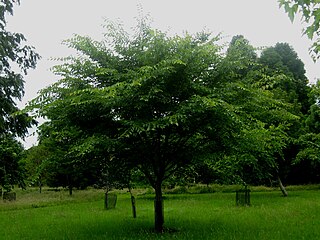
Sequoiadendron giganteum is the sole living species in the genus Sequoiadendron, and one of three species of coniferous trees known as redwoods, classified in the family Cupressaceae in the subfamily Sequoioideae, together with Sequoia sempervirens and Metasequoia glyptostroboides. Giant sequoia specimens are the most massive trees on Earth. The common use of the name sequoia usually refers to Sequoiadendron giganteum, which occurs naturally only in groves on the western slopes of the Sierra Nevada Mountains of California.

Boyce Thompson Arboretum is the largest and oldest botanical garden in the state of Arizona. It is one of the oldest botanical institutions west of the Mississippi. Founded in 1924 as a desert plant research facility and “living museum”, the Arboretum is located in the Sonoran Desert on 392 acres along Queen Creek and beneath the towering volcanic remnant, Picketpost Mountain. Boyce Thompson Arboretum is on U.S. Highway 60, an hour's drive east from Phoenix and 3 miles west of Superior, Arizona.

Betula nigra, the black birch, river birch or water birch, is a species of birch native to the Eastern United States from New Hampshire west to southern Minnesota, and south to northern Florida and west to Texas. It is one of the few heat-tolerant birches in a family of mostly cold-weather trees which do not thrive in USDA Zone 6 and up. B. nigra commonly occurs in floodplains and swamps.

The Bartlett Arboretum and Gardens in Stamford, Connecticut contains 93 acres of parkland, gardens, landscapes, and hiking trails that focus on the regional plants, ecology and character of Southwestern New England. The Arboretum is open and accessible to the public every day of the year and is located at 151 Brookdale Road.

The Harold L. Lyon Arboretum is a 200-acre (0.8 km2) arboretum and botanical garden managed by the University of Hawaiʻi at Mānoa located at the upper end of Mānoa Valley in Hawaiʻi.

The Government Botanical Garden is a botanical garden in Udhagamandalam, near Coimbatore(Ooty), Tamil Nadu state, India laid out in 1848. The Gardens, divided into several sections, cover an area of around 55 hectares, and lie on the lower slopes of Doddabetta peak. The garden has a terraced layout. It is maintained by the Tamil Nadu Horticulture Department.

Native plants are plants indigenous to a given area in geologic time. This includes plants that have developed, occur naturally, or existed for many years in an area.

Athrotaxis is a genus of two to three species of conifers in the cypress family, Cupressaceae. The genus is endemic to western Tasmania, where they grow in high altitude temperate rainforests.

The Guelph Arboretum of the University of Guelph is an arboretum modeled after the Arnold Arboretum of Harvard University, which was founded in 1872. The Arnold Arboretum is privately endowed as a department of Harvard just as the Guelph Arboretum is a department of the University of Guelph. The University of Guelph Arboretum was founded in the early 1970s and plantings started in 1971 which have developed into specialized gardens, botanical collections, and gene conservation programs. These Arboretums are demonstrations of American gardening which did not come into its own until the late 19th century. With Industrialization, cities grew in size with a need for natural areas, which were included through the creation of public parks. Views of botanical gardens began to change as they became sources for new material of potential horticultural use rather than only public spaces. Today these spaces act in the propagation of plants that have the potential as attractive and functional ornamentals.

Ulmus bergmannianaC.K.Schneid., commonly known as Bergmann's elm, is a deciduous tree found across much of China in forests at elevations of 1500–3000 m.

Ulmus laciniata(Trautv.) Mayr, known variously as the Manchurian, cut-leaf, or lobed elm, is a deciduous tree native to the humid ravine forests of Japan, Korea, northern China, eastern Siberia and Sakhalin, growing alongside Cerciphyllum japonicum, Aesculus turbinata, and Pterocarya rhoifolia, at elevations of 700–2200 m, though sometimes lower in more northern latitudes, notably in Hokkaido.

Ulmus chenmouiW. C. Cheng, commonly known as the Chenmou, or Langya Mountain, elm, is a small deciduous tree from the more temperate provinces of Anhui and Jiangsu in eastern China, where it is found at elevations below 200 m on the Langya Shan and Baohua Shan mountains. The tree was unknown in the West until 1979, when seeds were sent from Beijing to the De Dorschkamp research institute at Wageningen in the Netherlands.

Ulmus davidianaPlanch., the David, or Father David, elm, is a small deciduous tree widely distributed across China, Mongolia, Korea, Siberia, and Japan, where it is found in wetlands along streams at elevations of 2000–2300 m (6,500–7,500 ft). The tree was first described in 1873 from the hills north of Beijing, China.

The Lussich Arboretum is an arboretum of 192 hectares located in the Maldonado Department of Uruguay near Punta del Este and Punta Ballena.

Black Bayou Lake National Wildlife Refuge is one of five refuges managed in the North Louisiana Refuge Complex and one of 545 refuges in the National Wildlife Refuge System. It was established in 1997 through a unique partnership with the city of Monroe, Louisiana. The U.S. Fish and Wildlife Service has a free 99-year lease to manage the city-owned lake.

The Botanischer Garten Münster is a botanical garden maintained by the University of Münster.

The National Arboretum Canberra is a 250-hectare arboretum in Canberra, the national capital of Australia, created after the area was burned out as a result of the Christmas 2001 and 2003 Canberra bushfires: The Himalayan Cedar forest lost about one third of its trees, and the commercial Radiata Pine plantation was burned out, allowing the arboretum to be created.

Monvert Nature Park is a nature walk, arboretum, botanical gardens and rehabilitated indigenous forest, situated in Forest Side, Curepipe, Mauritius.

The Botanic Garden of Casimir the Great University is located in the center of Bydgoszcz, close to the main campus of the Kazimierz Wielki University in Bydgoszcz. The facility fulfils several roles: scientific research, but also didactic and recreational activities.




















